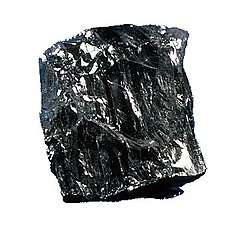Coal slurry
Coal slurry is a mixture of solids (mined coal) and liquids (water or organic)[1] produced by a coal preparation plant.
Preparation
To transform the coal ash into a slurry, coal is separated from non-combustable components and can be fractionated by particle size as well. Coal slurry can be transferred by pipeline or with specialized pumps such as a progressive cavity pump to pump the highly abrasive, corrosive and viscous coal slurry.[2] More than 7 billion tons of coal are mined per year (2010), using approximately 200 litres of water per ton.[3] However, the amount of water required hinges on the surface characteristics of the coal being used.[4] Most coal slurries require the addition of a surfactant to reduce the viscosity, ergo reduce the stress on pipelines and pumps.[5] Recent studies have employed new methods of slurry preparation, like using ultrasonic irradiation and a mixture of natural and synthetic surfactants to improve the stability and rheological properties of coal slurry.[6][7]
Environmental concerns

Ideally, coal slurry consists only of crushed coal and water, which can be efficiently separated. In practice, the separation is significantly costly due to the large amounts of water needed and wastewater generated by the process.[9] Furthermore, the slurry consists also of very fine coal dust that results in a waste called blackwater. As blackwater cannot be purified by a water treatment plant,[10] it is stored in large impoundment ponds. Such ponds are susceptible to disastrous releases, such as the Buffalo Creek flood of 1972 or the Martin County coal slurry spill of 2000, which released over 250 million gallons of coal slurry.[11] Coal slurry can contain hazardous chemicals such as arsenic and mercury and can kill aquatic wildlife, as was the case in the Martin County spill.[12] This impounded liquid waste can sometimes total billions of gallons[13] in a single facility.
References
- Shin, Yu-Jen; Shen, Yun-Hwei (2007-06-01). "Preparation of coal slurry with organic solvents". Chemosphere. 68 (2): 389–393. doi:10.1016/j.chemosphere.2006.12.049. ISSN 0045-6535. PMID 17276487.
- Admin. "Transferring coal slurry made easy". www.globalpumps.com.au. Retrieved 2019-04-11.
- The Coal Handbook: Towards Cleaner Production. Volume 1 ; Coal Production. Osborne, D. G. Cambridge: Woodhead Publishing Ltd. 2013. ISBN 9780857097309. OCLC 875224821.CS1 maint: others (link)
- Tillman, David (Summer 2012). "Coal-Water-Slurries". Solid Fuel Blending.
- Guo, D (1998-02-01). "Rheological behaviour of oil-based heavy oil, coal and water multiphase slurries". Fuel. 77 (3): 209–210. doi:10.1016/s0016-2361(97)00172-5. ISSN 0016-2361.
- Das, Debadutta; Dash, Uma; Meher, Jibardhan; Misra, Pramila K. (2013-09-01). "Improving stability of concentrated coal–water slurry using mixture of a natural and synthetic surfactants". Fuel Processing Technology. 113: 41–51. doi:10.1016/j.fuproc.2013.02.021.
- Guo, Zhaobing; Feng, Ruo; Zheng, Youfei; Fu, Xiaoru (2007-07-01). "Improvement in properties of coal water slurry by combined use of new additive and ultrasonic irradiation". Ultrasonics Sonochemistry. 14 (5): 583–588. doi:10.1016/j.ultsonch.2006.12.001. ISSN 1350-4177. PMID 17236802.
- Conlon, Kevin. "Officials: Coal slurry spill blackens 6 miles of West Virginia creek". CNN. Retrieved 2 May 2017.
- Andrews, Graham F., and Karl S. Noah. "The Slurry-column Coal Beneficiation Process." Fuel Processing Technology 52.1-3 (1997): 247-66. Print.
- Shiao-Hung Chiang and James T. Cobb "Coal Conversion Processes, Cleaning and Desulfurization" in Kirk-othmer Encyclopedia of Chemical Technology Wiley-VCH, 2000. doi:10.1002/0471238961.0312050103080901.a01
- Kilborn, Peter T. "A Torrent of Sludge Muddies a Town's Future." The New York Times. The New York Times, 25 Dec. 2000. Web. 25 Apr. 2019.
- Leung, Rebecca. "A Toxic Cover-Up?" CBS News. CBS Interactive, 01 Apr. 2004. Web. 25 Apr. 2019.
- "Coal Sludge Impoundments, West Virginia." NASA. NASA, 18 Mar. 2006. Retrieved 10 Apr. 2019.
External links
| Wikimedia Commons has media related to Coal slurry. |
